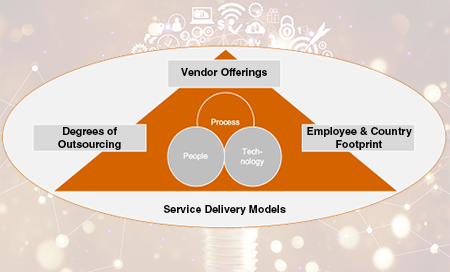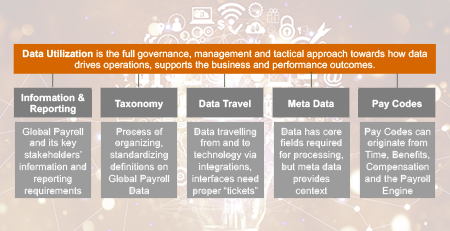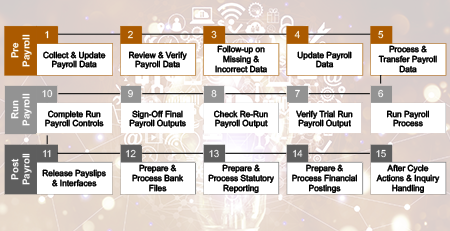Part 1 of this series addressed the holistic and best practice approach in response to the rising expectations of companies toward global payroll. This approach to global payroll management identifies four components that must be addressed holistically to ensure global payroll’s success. Those components are:
- Global payroll strategy
- Global payroll governance model
- Global payroll operating model
- Global payroll operations
Part 1 in the December 2019 issue briefly discussed each component. Part 2 ran in the January issue and closely examined global payroll strategy and the global payroll governance model.
Here, Part 3 takes a closer look at the two remaining components—global payroll operating model and global payroll operations.
Component 3—Global Payroll Operating Model
The global payroll operating model is the tactical component to developing a model that delivers on the strategic promise, embeds governance, and enables operations. This component is composed of these five sections:
- Service delivery models
- Ways of working
- Technology
- Data utilization
- Performance
Service Delivery Models
Global payroll, at its core, is a process, effectuated by people and enabled by technology. There are vendor offerings and degrees of outsourcing around this process that apply to the employees and country footprint of global payroll. This is what is referred to as service delivery models.
Vendor offerings can be categorized arbitrarily in local solutions, aggregators (technology and/or services), and global payroll providers. These vendors and other consulting partners often offer various degrees of outsourcing. This can range from technology services to payroll services, HR data entry, and payroll advisory services. Based on these degrees of outsourcing and vendor offerings, four different models are identified:
- Cloud
- Processing
- Managed
- Business process outsourcing
The industry is realizing that the one-size-fits-all approach is hybrid. Although the employee and country footprint of most companies can be characterized in the same way (i.e., headquarters and secondary payrolls with high headcount, low country volumes, and long-tail payrolls with low headcount, high country volumes), the balance of vendor offerings and degrees of outsourcing is often a wonderfully complex puzzle, which ultimately leads to a unique set of service delivery models (see Figure 1).
Figure 1—Service Delivery Models

This section of global payroll management is often the most discussed in professional networks and online because it drives operations and what vendors talk about the most. Critical to realize, however, is that it only forms one section out of 20 (5%) that together make up global payroll management.
Ways of Working
In an increased global, virtual, and culturally complex working environment (especially for global payroll) it’s strongly advised to clearly articulate “ways of working.” This describes the expected norms around collaboration, language, communication style, and general business behaviors. This section is particularly crucial for building and maintaining the global payroll brand. Practically, having formalized ways of working dictates the following at a minimum:
- Language used during service delivery when corresponding with employees (formal tone, informal tone, email, call, chat, English, local language, etc.).
- Enabling video during online sessions to enhance participation and focus on the topic instead of multi-tasking, while respecting time zone differences.
- Email behavior, such as a mantra of only sending emails when absolutely necessary and calling someone rather than sending lots of follow-up emails.
- Empowering and trusting staff to make decisions quickly.
These are just some examples of the importance of having ways of working that make collaborating across the globe a true joy.
Technology
The increased role of enabling technology is accepted, appreciated, and addressed across the globe and industry. Although technology is there to support processes in global payroll and was originally just part of a job for global payroll professionals, there is now a need for a more formal “ownership” of the technology landscape. This can be called the global payroll technology ecosystem—from where payroll starts (at pre-payroll) to where payroll ends (at post-payroll).
There is great value in fully understanding the architectural touchpoints between systems across the global payroll landscape, as this drives the operating model and operations and enables data utilization. For instance, answers to the questions below must be based on the design principles as part of the global payroll strategy component:
- Is it allowed to build integrations, or are manual uploads or entries allowed in certain circumstances?
- Do we explore opportunities for robotic process automation (RPA) to perform data re-keying capabilities?
- Is software as a service or the cloud the directive and on-premise software is excluded, or are exceptions allowed?
- Who ensures all systems are connected, sequenced, and maintained?
- Is there a need for a central data repository to unlock value from data?
These types of questions and topics are to be addressed as a formal section of the global payroll operating model in close connection with the section about innovation in the global payroll governance model. It’s time to firmly wrap our arms around technology.
Data Utilization
Data is the ever-present driver in global payroll. How we look at utilizing data, however, has not been as integral to business operations in the past as it is now. This is why data utilization is a formal section of the global payroll operating model.
Data utilization is the full governance, management, and tactical approach toward how data drives operations and supports business and performance outcomes. From practical experience, a good way to unlock the value from data is to first understand the data. This means there is a need for common terminology (taxonomy), a need to understand how data travels, what metadata (data enriching payroll results) is available, and how pay codes are bucketed to global pay codes for central and consolidated reporting (see Figure 2).
Figure 2—Common Taxonomy to Unlock Data’s Value

Once there is a common understanding of the data, it can support information and reporting both for global payroll’s own processes and for key stakeholders. The added value can be seen in a continuum—from opinions and data to insights and actions.
Performance
Performance of global payroll is often measured based on indicators such as accuracy, timeliness, first-time-right (and root-cause analysis), processing timelines, and inquiry handling. Meet with your teams, contractual partners, and stakeholders to define real performance indicators (linked to the strategic objectives) to measure what matters.
Performance reviews are best approached holistically. This means not in isolation within the global payroll function alone. A best practice is to have joint sessions—for instance, with the HR team responsible for submitting or even processing pay-relevant changes and with local vendors. There can be misunderstandings or underappreciation of each other’s positions and data needs. To be fully aligned, a positive, forward-thinking, and collaborative mindset is needed. It’s important to measure performance based on the real story supported by data proof points (from data utilization and vendor input) that everyone understands.
Component 4: Global Payroll Operations
Global payroll operations is where the delivery of payroll processes occurs, or, as referred to in Part 1—where the daily magic happens! This component is composed of these five sections:
- Service delivery
- Global payroll processes
- Records and information
- Operational excellence
- Project delivery
Service Delivery
Global payroll professionals, whether experienced or not and regardless of whether they are serving small or large headcounts, all strive for the best service delivery. This is in our DNA, and we are intrinsically motivated. We strive for the highest standards and will not rest until we have achieved this.
This section of global payroll operations is where most, if not all, sections are operationalized. It covers all of the interactions with staff and stakeholders on a day-to-day basis. The actual delivery is heavily dependent on the chosen service delivery model and often a combined effort of cross-functional team and contractual partners. Juggling between priorities and deadlines, pay must be deliver accurately, on time, and in compliance. Performance is therefore measured as part of service delivery and includes service delivery reviews that must be aligned with the overall purpose statement of global payroll.
Global Payroll Processes
Global payroll has many local variances, complexities, and requirements; however, the sequencing of steps in the core cyclic payroll process is the same.
Figure 3—Steps in the Global Payroll Process

This 15-step global payroll process starts with pre-payroll, continues with run payroll, and ends with post-payroll (see Figure 3). The common process helps to identify how, for instance, the service delivery models differ from each other in operations, how the global payroll technology ecosystem maps to each step, what data utilization is required as a result of each step, and which standard operating procedures (SOP) must be maintained to ensure proper process documentation and execution. Lastly, this process can help to visualize the service delivery models when sourcing and when people are mapped to each step in the process.
Aside from the core cyclic payroll process, there are many recurring and non-recurring processes that form part of global payroll processes. For example, formalized processes around a risk and control review, either on a global, regional, and local level are best operating when formalized and recurring.
Records and Information
In domestic and global payroll, the processing of records, documents, and information has always been a standing topic of attention. Since the implementation of the General Data Protection Regulation (GDPR), there are more stringent rules around data processing, recording, and maintenance. In some countries or states, there are now localized versions of GDPR with nuances that impact global payroll operations.
Personal data and sensitive personal data are kept in our ecosystem, so ensuring that all data (documents, information, payroll records, personnel information, contracts, etc.) in the end-to-end global payroll processes are identified, labelled, and retained in compliance with global and local standards is of vital importance.
A best practice is to have a policy that sets the standards (reference is made to Part 2, covering policies and standards) around records and information. For instance, there can be a global document type called payroll records, but the retention period is set on a local level. Global where you can, local where you must.
Operational Excellence
Let’s challenge ourselves to always be more efficient and effective and challenge the status quo. This is a mindset by which operational excellence flourishes. Operational excellence, or continuous improvement, is an integrated section of global payroll operations. The tools supporting operational excellence, such as Lean or Six Sigma, deliver results when staff in operations are transparent by sharing practices, incidents, and learning.
Operational excellence is not just about improving for the sake of being more efficient, but also to optimize service delivery to meet the needs of employees and stakeholders. It includes specific behavioral elements.
For instance: “I follow principles, ways of working, and processes because I want to. I make sure others also follow these principles, ways of working, and processes.” This is a behavior ensuring a commitment to excellence and a focus on engagement. If anything, operational excellence is a mindset!
Project Delivery
With global payroll at the intersection of HR, tax, and finance, there is hardly a project that does not impact global payroll. With a focus on service delivery, global payroll professionals are required to participate in project delivery (and sometimes project management) above and beyond their operational responsibilities.
Therefore, it is important to recognize this increasingly prominent part of the job in a separate section as part of global payroll operations. Oversight in all global and local projects is required to ensure the proper design decisions (aligned with the design principles) are made, projects are not overlapping, and allocation of staff is concisely managed. Projects are not accidental in global payroll. They are here to stay. Staff needs recognition and support in these efforts to make the best use of their time, skills, knowledge, and abilities.
Closing Thoughts, Considerations
Global payroll is evolving as a function, profession, and industry. This is an exciting time to be a global payroll professional. There have been successful and unsuccessful global payroll transformations, all of which we can learn from.
Whatever your approach is, remember to take a holistic approach to global payroll management. Your knowledge and experiences should be shared, not possessed.

Max van der Klis-Busink, RPP, holds a Bachelor of Business Administration in Human Resource Management and is a Registered Payroll Professional (RPP) in The Netherlands. He currently holds the position of Payroll Manager Netherlands and Policy Lead, Global Payroll Strategy, at Shell’s global headquarters in The Hague. Over the past 13 years, Van der Klis-Busink held various roles in global payroll and has been active in developing the profession. He has developed a best practice method for being in control of global payroll and specializes in building payroll functions that continue to adapt to ever-changing business needs. Van der Klis-Busink has shared his passion for payroll through multiple articles in global payroll, webinars, and by co-developing and instructing certificated programs in global payroll, together with the Global Payroll Management Institute (GPMI). In 2018, Van der Klis-Busink was the first-ever recipient of the GPMI’s Global Vision Award.